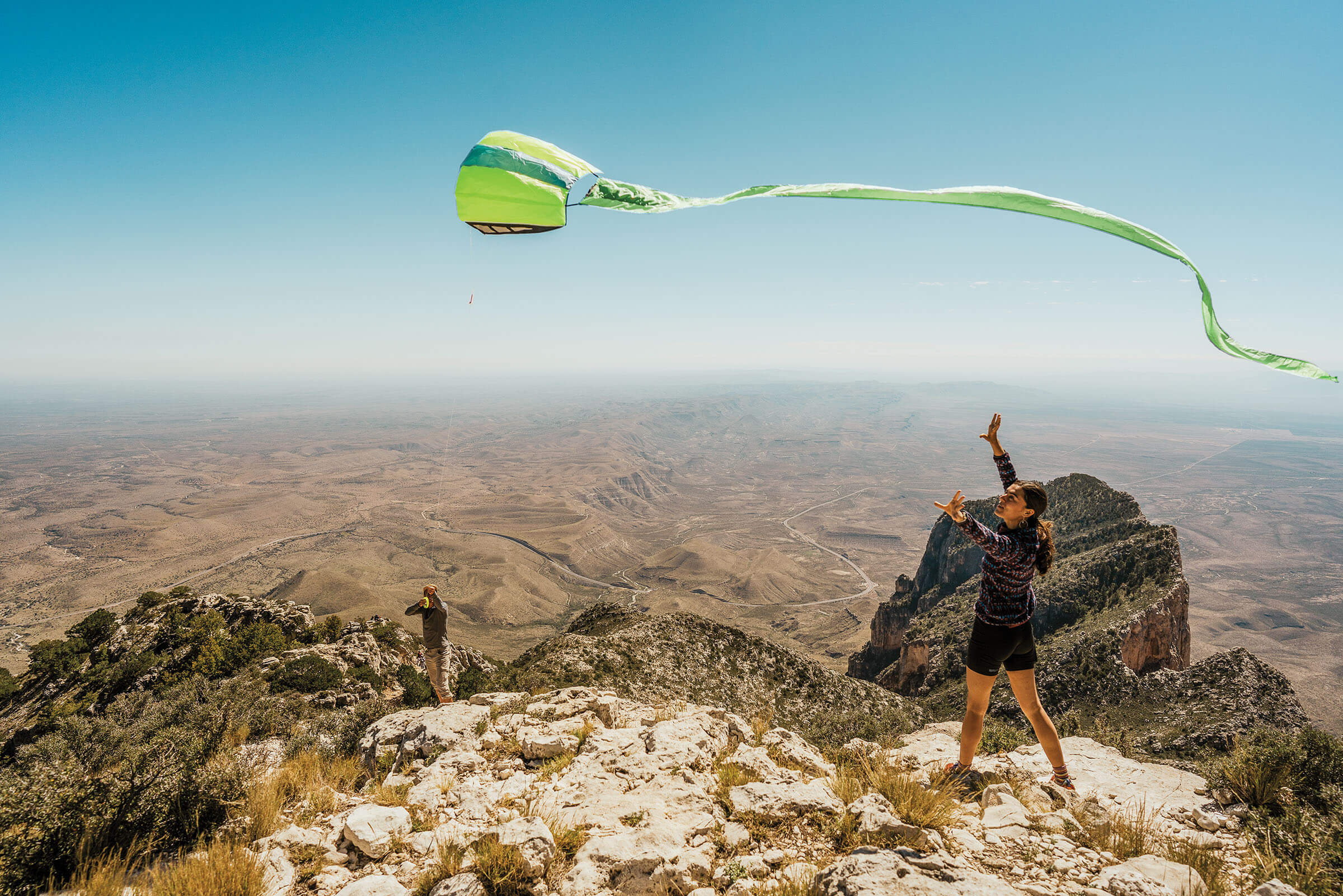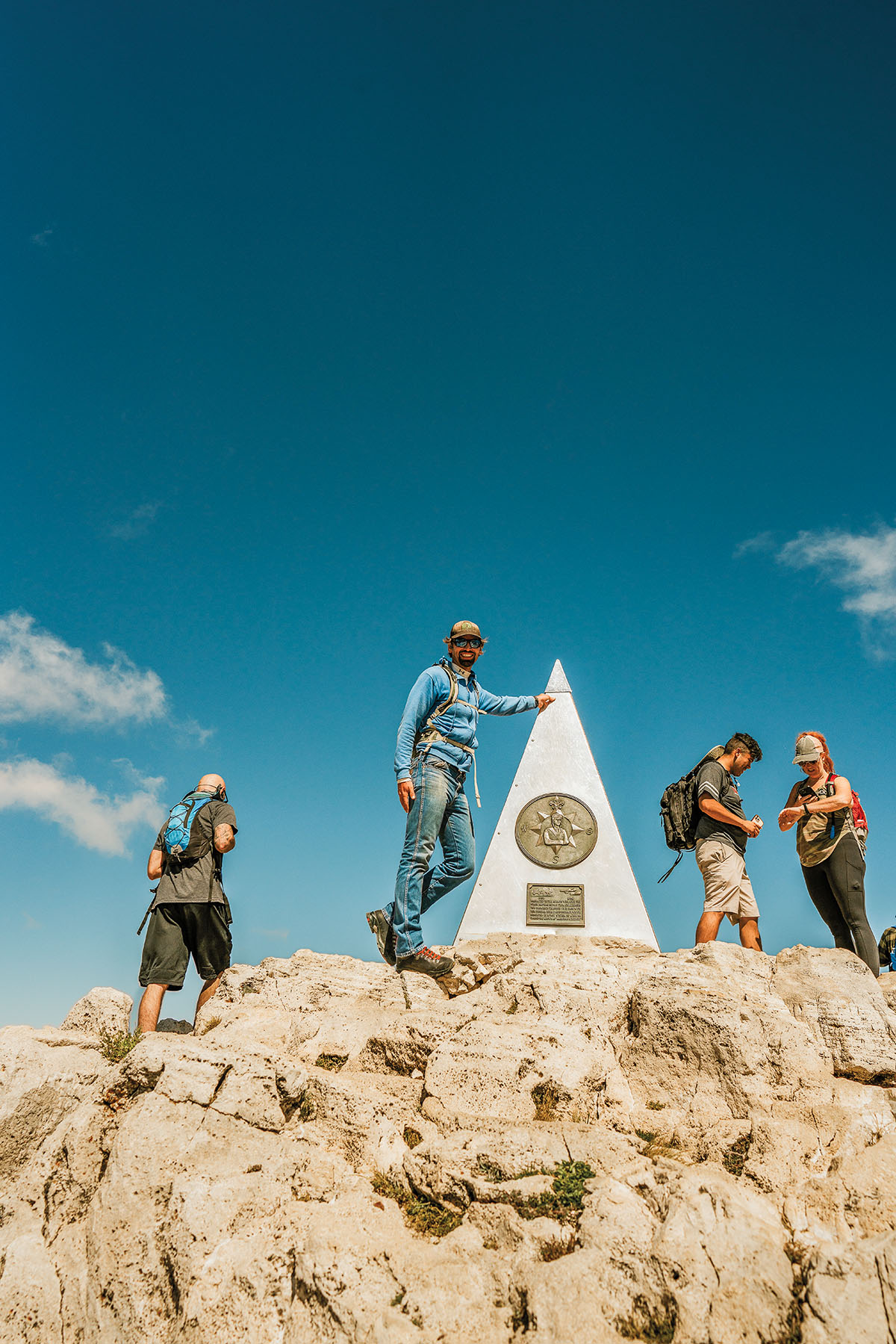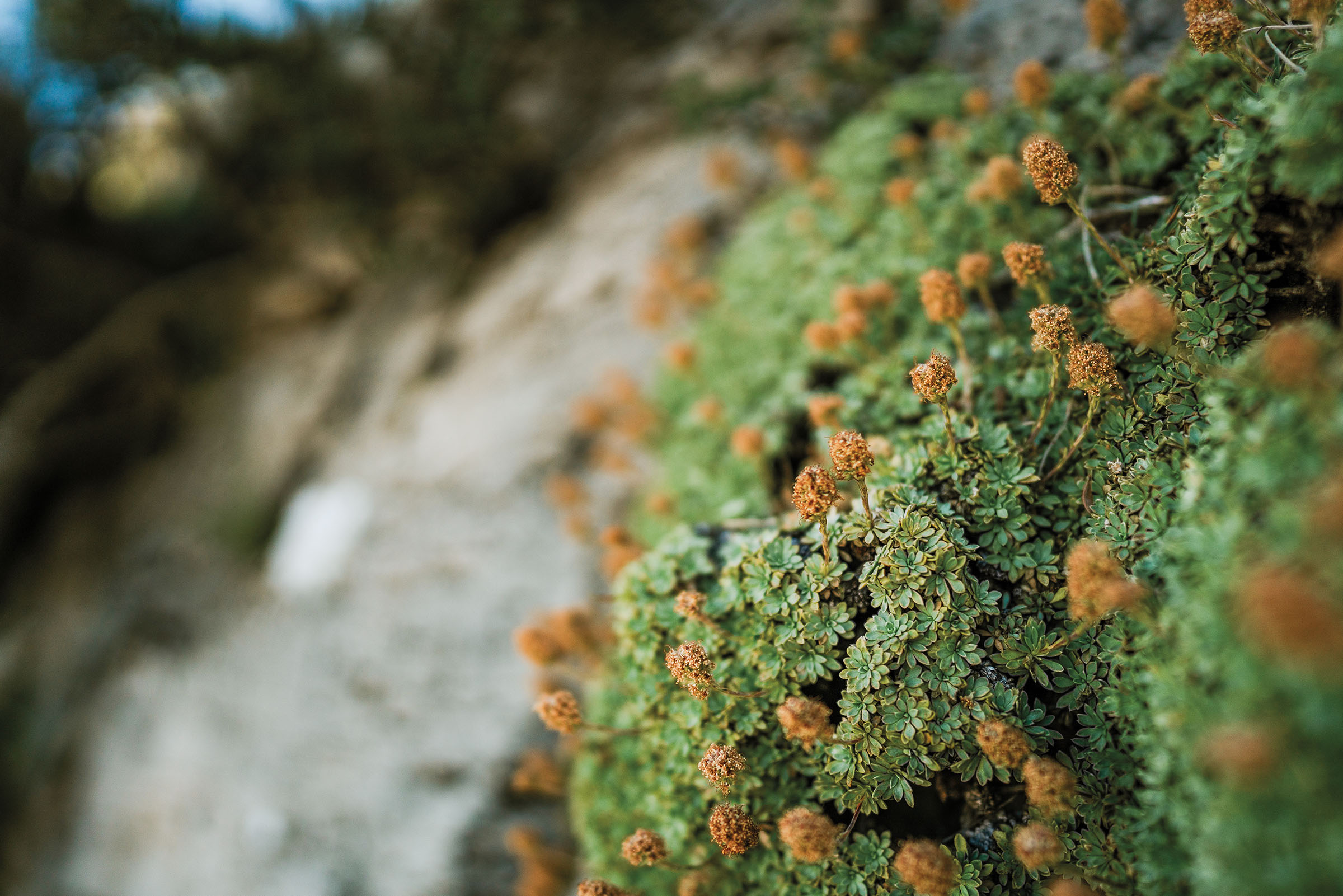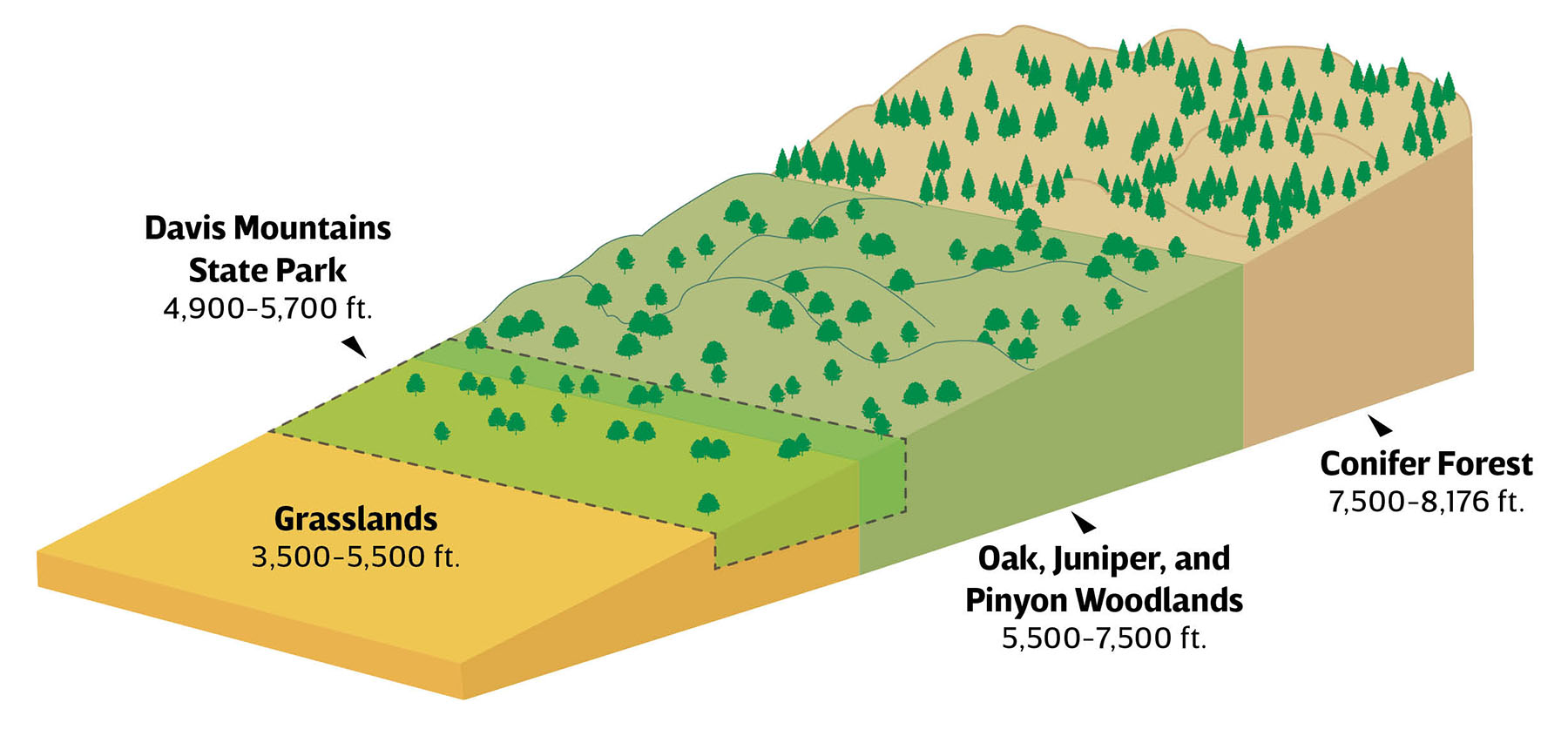
The wind at the top of the Guadalupe Mountains offers optimal flying conditions.
I’m maybe 10 miles from Baldy Peak in the Davis Mountains of far West Texas, looking down at an undulating fog bank that completely obscures the valley below. It’s like a mysterious sea with a forest-blanketed peak to the rear on a landmass ascending out of it. I don’t know what’s below the gray waves. Whatever is down there, it’s a different place from up here. I’m on a sky island, another name for the Chisos, Davis, and Guadalupe mountains that rise out of the surrounding Chihuahuan Desert and have their own distinct ecosystems.
Sky Islands Tour
Book a guided hike
with Far West
Texas Outfitters.
farwesttexas
outfitters.com
“About 20,000 years ago, we were in an ice age. The Trans-Pecos plant communities looked completely different,” says Kaylee French, West Texas education and outreach coordinator for The Nature Conservancy, which manages the 33,000-acre Davis Mountains Preserve. “As temperatures warmed over the next 11,000 years, we had a plant community transition, and at the lower elevations, what’s now the Chihuahuan Desert developed.”
The plant and wildlife relics of the old forests that remained higher up, and depend on cooler and wetter conditions to survive, offer a glimpse into an isolated world of great biodiversity. For much of the last decade, the Trans-Pecos sky islands have played a central role in Tyler Priest’s life, first as a ranger at Davis Mountains State Park, where he would pass out leis to visitors to play up the island vibe; and now as an occasional columnist for the Big Bend Sentinel and tour guide for the adventure group Far West Texas Outfitters. When Priest leads hikers on three-day excursions from a base camp in Marfa to all three spots, he encourages participants to monitor how the landscape changes from the scrub and grasslands below to the forested mountains above. The higher you go, the greater the change, as new biomes present themselves.
For perspective, Baldy Peak tops out at an elevation of 8,378 feet. Forty miles away, the spring-fed desert swimming hole at Balmorhea State Park sits at only 3,196 feet. You won’t see rare species such as the Rivoli’s hummingbird, with its purple crown and turquoise throat, hanging out around the pool. But you will around Baldy Peak. More than a dozen other species of hummingbirds migrate through here as well. In the not-too-distant past, they shared this territory with Mexican gray wolves and grizzlies. Black bears and cougars still prowl this high country.
“It’s a completely different environment up there,” Priest says. “You have a few groves of quaking aspens. You have the largest ponderosa pine in the state of Texas—so big you can’t even wrap your arms around it. It’s a massive tree. You’d never guess that way out here in the Chihuahuan Desert we have such places.”

The Chisos Mountains in West Texas are a “sky island” with multiple ecosystems.
Each hike is a challenge, but the medley of wildlife and vegetation makes it worthwhile. Rare Colima warblers and Mexican jays are in the avian-rich Chisos Mountains along with Say’s phoebes, cactus wrens, white-throated swifts, Scott’s orioles, black-headed tanagers, and hepatic tanagers. The Davis Mountains are home to reclusive Montezuma quail. Pygmy nuthatches and juniper titmice, found nowhere else in Texas, can be spotted in the Guadalupes.
“The Guadalupes are also where you can find the only viable reproducing trout stream in Texas,” says Ben Sandifer, a master naturalist and environmental activist from Dallas. “It’s in McKittrick Canyon, one of the brilliant areas in Guadalupe Mountains National Park.”

The summit at Guadalupe Peak

Guide Tyler Priest

Mat rock spiraea, a native Texas plant
In addition to the ponderosa pines and aspens, plants that might seem otherworldly to most Texans turn up in the sky islands. Among the most impressive are the madrone trees in the Guadalupe and Chisos mountains. They have multiple twisted trunks and interwoven branches electrified in combinations of red, green, and white wood. Their leaves are an eye-catching bright green. In early fall, they produce red berries that cover the plants in clusters, and the color palettes make them the showiest native tree in Texas. Another find: the sublime Hidalgo ladies tress, one of about 50 species of wild orchids in Texas. This is the rarest, found only in the Chisos Mountains. It wasn’t even known to exist in the United States until the 1930s. And now it’s already under threat, as new environmental factors once again stand to impact the landscape.
“Climate change is producing longer and more destructive droughts,” Priest says. The lack of adequate rainfall has weakened ponderosa pines in the Davis Mountains, making them more susceptible to beetle infestation. The droughts have also increased the danger of wildfires, many caused by lightning. The Rock House Fire began near Marfa on April 9, 2011, and reached Fort Davis in just an hour. It incinerated 314,444 acres over a month before it was contained. “Burn scars” on a NASA Earth Observatory Landsat image show the bulk of the damage was in the Davis Mountains. More than a decade later, plant and wildlife populations are still recovering, and an equally destructive fire could strike during an upcoming dry season.

The Sky’s the Limit
Hikers can observe increasingly varied forms of vegetation and wildlife as they ascend the different biomes of the Davis Mountains.
Sky islands exist in other mountain ranges throughout the southwestern United States, northern Mexico, and elsewhere in Texas. Sandifer cites areas in the Hill Country, including uplifts near the headwaters of the Guadalupe River and along the Frio River near Leakey. He located small “niches where time is forgotten” near the Paluxy and Brazos rivers, including Chalk Mountain midway between Glen Rose and Stephenville. “It’s a holdout area for black-capped vireo and the golden-cheeked warbler,” Sandifer says. “The property owners curate it through a wildlife exemption to create habitat for those two endangered species.” He climbed to the top, where he saw all the way to Stephenville and Hico. He found scrub oak and juniper coexisting in the same habitat, which is necessary for the vireos. Sandifer knows of similar terrain in Montague County and near Gainesville.
There are also the Medicine Mounds in Hardeman County between Quanah and Chillicothe. The largest, known as the Medicine Mound, peaks at only about 300 feet above the plains. But it’s still a kind of sky island. “The Medicine Mounds are completely isolated from similar habitats and environments for many, many miles around,” Sandifer says. “The main reason for that is farming and grazing on the flatter areas below. The Medicine Mound is really too steep for a cow to climb. So, what you’re left with is what the area looked like prior to settlement by Europeans—a time gone by.”
Standing near Baldy Peak, I see the gray waves start to part. The landscape below comes into focus, revealing a dramatic contrast in topography. Priest catches my gaze. “Throughout our history,” he says, “humans have been drawn to sky islands. They are what made me fall in love with this part of Texas.”








